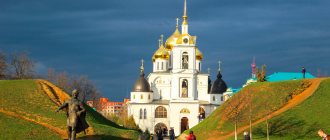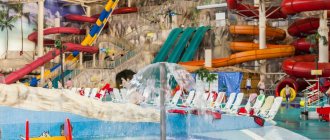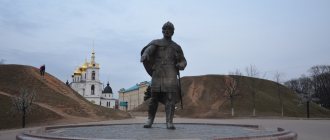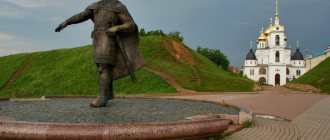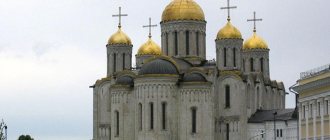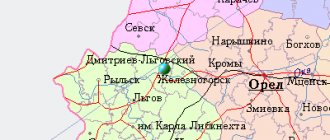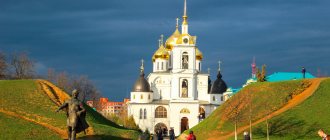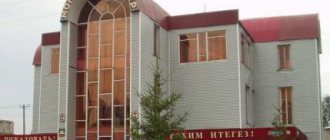Dmitrov is one of the most beautiful cities in the Moscow region: the hills of the Klinsko-Dmitrovskaya ridge, the Moscow canal, the ancient Kremlin, temples and monasteries, ancient houses and estates... In this small guide, compiled on the basis of our own numerous trips to Dmitrov and the Dmitrovsky district (now Dmitrovsky city district), I will try to talk about what, in my opinion, deserves attention here.
Dmitrov Kremlin and monument to Yuri Dolgoruky
Dmitrov's story
People have long settled in these areas, as evidenced by numerous mounds, fortifications and sanctuaries. Dmitrov is not much younger than Moscow - Prince Yuri Dolgoruky founded it in 1154 on the site of an ancient Slavic settlement and named the city in honor of his son Vsevolod (baptized Dmitry) who was born that year. The location was chosen well: near the Yakhroma River, from where the trade route to the Volga went along Sestra and Dubna. Another, land route went to Klyazma, and from there to Vladimir.
In the 12th century, impenetrable forests and swamps began immediately behind Dmitrov. The city served as a northwestern outpost of the Vladimir-Suzdal principality and occupied an important strategic position, covering the road to Suzdal along the Vela and Dubna rivers.
Coat of arms of the city of Dmitrov
Dmitrov was ruined more than once - both by the Mongol-Tatars and by the appanage princes and relatives. To stop the civil strife, the Dmitrov Congress of Princes was convened here in 1301, which was attended by Grand Duke Andrei Alexandrovich of Vladimir (son of Alexander Nevsky), Prince of Tver Mikhail Yaroslavich (nephew of Alexander Nevsky), Prince of Moscow Daniil Alexandrovich (youngest son of Alexander Nevsky), Pereslavsky Prince Ivan Dmitrievich (grandson of Alexander Nevsky). However, the truce did not last long, and four years later the princes resumed the showdown.
The Dmitrov Congress of Princes was reflected in the city’s coat of arms, which Dmitrov received in 1781:
At the top of the shield is the Moscow coat of arms. At the bottom there are four Princely crowns, in an ermine field, in memory of the famous Four Russian Princes Congress that was held in that city.
— The Highest Decree of Empress Catherine II of December 20, 1781
In 1364, the Dmitrov Principality was annexed to Moscow. From that time on, it belonged to one of the younger brothers of the Moscow princes, who bore the title of princes of Dmitrov. The first prince who lived and died here was Peter (1389-1428), one of the younger sons of Dmitry Donskoy. At the end of the 14th – beginning of the 15th century, during the period of civil strife between Dmitry Shemyaka and Vasily Kosy with the Moscow prince Vasily II the Dark, the city repeatedly changed hands. The last prince of Dmitrov was Yuri, the second son of Ivan III.
Under Prince Yuri (ruled 1505-1533), Dmitrov reached his greatest prosperity. The Assumption Cathedral was erected in the Kremlin, and the Boris and Gleb Monastery was rebuilt in stone. An important trade route to the north ran from Moscow through Dmitrov, and the city grew rich.
Apollinary Vasnetsov. "Dmitrov in the 16th century"
In 1556, Ivan the Terrible exchanged Dmitrov for Staritsa from Prince Vladimir Andreevich Staritsky. After the execution of the latter in 1569, Dmitrov finally went to Moscow. The oprichnina almost completely devastated the city.
In January 1610, the troops of Jan Sapieha, who had retreated from the walls of the Trinity-Sergius Monastery, gained a foothold in Dmitrov. The ancient wooden Kremlin was burned, the city was depopulated. After the Time of Troubles, Dmitrov never achieved its previous level of prosperity, turning into a quiet merchant and craft town. In 1781 it received the status of a district town of the Moscow province, and in 1784 it received a regular development plan. The revival of trade contributed to the prosperity of the Dmitrov merchants. In the picturesque Dmitrovsky district, estates of the richest families in Russia are being built.
“Projected” plan of the city of Dmitrov in 1784 from the “Complete Collection of Laws of the Russian Empire. Book of drawings and drawings. City plans"
In September 1812, when Napoleon occupied Moscow, a French detachment settled in Dmitrov. However, having learned about the approach of the Russian army from Klin, he hastily left it.
After the construction of the Nikolaevskaya railway, which passed through Klin, and the Yaroslavl railway through Sergiev Posad, Dmitrov found himself somewhat aloof from traffic flows. River trade, which fed the city in the past, had by that time lost its relevance. In 1900, the Savelovskaya Railway passed through Dmitrov, thanks to which the city received a new impetus for development.
On August 11, 1918, in Dmitrovsky district there was an uprising of local residents against the additional seizure of food, which was brutally suppressed. The instigators were shot on Cathedral Square in Rogachevo. The ashes of the dead Red Army soldiers were transported to Dmitrov and buried in the park on Zagorskaya Street.
In 1932, construction of the Moscow-Volga Canal . The canal was built by prisoners from Dmitlag (a division of the Gulag) and civilians. The leadership of Dmitlag was located in the Dmitrov Boris and Gleb Monastery. Prisoner barracks stood along the entire length of the canal; The names of that time have survived to this day: 3rd section, 4th section, Pace, Competition and others. The canal and hydraulic structures were built almost by hand, without the use of special equipment. The section between Iksha and Dmitrov, which crosses the Klinsko-Dmitrovskaya ridge, turned out to be one of the most difficult, with a large number of locks concentrated here.
Excavation and transportation of soil, photo from the site www.moidmitrov.ru
The total number of Canal Army soldiers killed is still unknown; figures range from 0.7 to 1.5 million people. Nowadays, during construction along the canal, unmarked mass graves are often found. In 1937, many Dmitlag leaders, civilians and former prisoners were shot.
On April 17, 1937, the canal began to be filled with water. On May 1, the first flotilla of Volga ships arrived in Dmitrov. On July 15, permanent navigation began along the Moscow-Volga Canal.
Moscow Canal in Dmitrov
In November 1941, fascist German troops managed to break through the canal and gain a foothold on the dominant Peremilov heights near Dmitrov, from where they were driven out during fierce battles on November 29 - December 5. From here the counter-offensive of the Red Army began. In memory of those events, a memorial was created in 1966 at Peremilov Heights. To stop the enemy's advance, the canal's spillways were opened by December 1, 1941. A huge territory from Yakhroma to the Ivankovo Reservoir went under cold water, thereby stopping the enemy’s advance in this direction.
♦ On the subject: Wall of water: the Moscow Canal during the war
Memorial "Peremilovskaya Heights"
After the war, construction in Dmitrov continued. Over time, old attractions were restored and new ones appeared. And today Dmitrov has turned into one of the most comfortable cities in the Moscow region.
Monument to the holy noble princes Boris and Gleb near the Boris and Gleb Monastery
DMITROV
DMITROV, a city in Russia, in the northern part of the Moscow region, the center of the Dmitrov urban district. Population 68.8 thousand people. (2019). Located on the river. Yakhroma, cargo port on the Moscow Canal. Railroad station. The Moscow-Dubna highway passes through Dmitrov.
Story
Founded in 1154 by the Rostov-Suzdal prince Yuri Vladimirovich Dolgoruky and named in honor of his son Vsevolod Yuryevich Big Nest (baptized Dimitri). From 1157 it was part of the Grand Duchy of Vladimir (after 1212 - in the Principality of Pereyaslavl). In the beginning. 1181 burned by Prince Svyatoslav Vsevolodovich. In 1213, during a strife between the sons of Vsevolod the Big Nest, the Dmitrovites themselves burned the city settlement (which probably appeared in the last quarter of the 12th century) and repelled the attack of the Yuriev prince Vladimir Vsevolodovich, destroying part of his squad.
In the beginning. 1238 Dmitrov was devastated during the Mongol-Tatar invasion. Since 1247, one of the centers of the Galicia-Dmitrov Principality, and after its collapse (between 1280 and 1334) - the Dmitrov Principality (about 1360 it became part of the Moscow Grand Duchy). Repeatedly subjected to Horde raids in the 13th–15th centuries. In 1372 it was captured by the Grand Duke of Tver Mikhail Alexandrovich. The city was taken by one of the Horde detachments during the Tokhtamysh raid of 1382, and was devastated during the Edigei raid of 1408. In 1389, Dmitrov with the adjacent volosts formed the appanage Dmitrov principality, allocated to Prince Peter Dmitrievich. From 1428 it became part of the grand ducal possessions. In the end 1454 – beginning 1455 Dmitrov went to the son of the Grand Duke of Moscow Vasily II Vasilyevich the Dark - Yuri Vasilyevich, after his death (1472) - to the Grand Duke of Moscow Ivan III Vasilyevich, who allocated him to feed Prince Andrei Borisovich of Mikulin, who transferred to the Moscow service. According to the will of Ivan III, the city became the center of the possessions of his son, Yuri Ivanovich (1504–33). In 1566–69 Dmitrov belonged to Prince Vladimir Andreevich. At 15 – 1st half. 16th centuries - a major center for trade in salt, fish, bread, from the 16th century. – production of polished ceramics; Pottery, ironworking, blacksmithing, and jewelry making were developed. The wealth of Dmitrov merchants was noted by S. von Herberstein.
During the Time of Troubles, Dmitrov was briefly captured by the detachment of Ya. P. Sapieha. Changes in trade routes in the 2nd half. 16th century and the ruin of Dmitrov in 1610 led to the economic decline of the city. In the 17th century There were palace settlements in the city (stable settlement, etc.). In 1708–1929, a district town in the Moscow province. In 1900, the Moscow–Savelovo line of the Northern Railways passed through Dmitrov. During World War I, many enterprises in Dmitrov and the district switched to producing military products. In 1918–21, the anarchist theorist P. A. Kropotkin lived in the city, participating in the creation of the local museum. For the construction of the Moscow-Volga canal (from 1947 the Moscow Canal), the Dmitrovsky forced labor camp of the OGPU (from 1934 NKVD; Dmitlag), which was subordinate to the Gulag (1932–38), was created. During the Great Patriotic War, during the Battle of Moscow 1941–42, fierce battles took place near Dmitrov in November 1941 between the Red Army and German troops. In 1929–2018, the regional center of the Moscow region. City of Military Glory (2008). From 2022, a city of regional subordination of the Moscow region, the center of the urban district.
Archeology
Ensemble of the Nikolo-Peshnoshsky Monastery. Photo by A. I. Nagaev
Dmitrov. Assumption Cathedral. Between 1509 and 1533. In the foreground is a monument to Yuri Dolgoruky (2001, sculptor V. Tserkovnikov). Photo by A. I. Nagaev
Dmitrov is an important archaeological site. Its cultural layer up to 2 m thick (divided into three horizons: 11th–13th centuries, 14th–15th centuries and 16th–17th centuries) was identified on the territory of the Kremlin, as well as on the settlement to the northeast of the Kremlin. Detinets (200×120 m) is protected along the perimeter by a rampart (has three breaks, two of which - from the northeast and southwest - on the site of an ancient gate) and a ditch. A wooden wall with towers ran along the shaft; the remains of piles driven into the embankment were discovered. In the horizon of the 11th–13th centuries. (thickness 0.3–0.5 m), including a layer of coal with the remains of wood (possibly traces of fire 1181), fragments of molded and circular dishes, tools, jewelry, etc. were found. Many coins were found on the territory of the Kremlin, which indicates wide trade connections of the city. Remains of wooden dwellings from the 12th–17th centuries have been excavated. with ovens made of clay or square bricks. In the southwestern part of the Kremlin (on the site of the building of the Noble Assembly), a unique cemetery dating from the 12th to 16th centuries was studied. with a total area of at least 400 m2 (out of 177 buried, 100 had a south-southwest orientation of the head, 25 - southwest, 10 - south and only 6 - the usual west; a rich burial of a girl from the 12th-13th centuries was found with silver jewelry and gold sewing a collar, which indicates the high social status of those buried in this cemetery).
Architecture
In accordance with the master plan of 1784, the original radial structure of Dmitrov was largely replaced by a geometric grid of blocks. On the territory of Detinets, the 5-domed, 4-pillar Assumption Cathedral on a high basement has been preserved (between 1509 and 1533; according to some researchers, 1510s), erected on white stone basements with faceted apses and monumental tiled compositions depicting the Crucifixion and St. George Victorious (1st half of the 16th century or 2nd half of the 15th century); central iconostasis – con. 17th century with icons from the 16th–18th centuries. The aisles with pseudo-Gothic elements were built on the site of ancient galleries - the northern one (laid in 1823, architect F. M. Shestakov) and the southern one (project 1841, architect D. F. Borisov). The bell tower of the cathedral (1793–96, architect M. Ya. Agafonov) was built in 1820 according to the design of architect. A.F. Elkitsky. Nearby is the Elizabethan Church (1897–98, architect S.K. Rodionov). Not far from the Kremlin is the Borisoglebsky Monastery (according to legend, founded by Prince Yuri Vladimirovich Dolgoruky, the first documentary evidence of it dates back to 1472; closed in 1926, reopened in 1993) with the single-domed Cathedral of Saints Boris and Gleb (until 1537; restored in the 1900s . under the leadership of architect I. P. Mashkov; Alekseevsky chapel - the burial vault of the Chaplin family of nobles, 1656), the gateway St. Nicholas Church (1672–87; rebuilt in 1834, 1852) and the fence (1685–89). Among other monuments: churches in the Baroque style - Spasskaya (1767–73), Ilyinskaya (1778–83), Troitskaya-Tikhvinskaya (1795–1801); samples of wooden Empire and neo-Empire styles (houses of the Klyatovs, Novoselov, Vadbolsky). Complex of the Podlipichye estate (which became part of the city in the 1930s) - the main house (2nd half of the 18th century, twice rebuilt in the middle - 2nd half of the 19th century, with eclectic decor) and Kazan church (1735–53; chapel, 1778–79, architect I. M. Samarin). In the Zarechye area there is the baroque Vvedenskaya Church (1766; iconostasis, 2nd half of the 18th century; bell tower, 1786, 1832), the estate of A. I. and I. A. Tolchenov (the main building of the merchant estate, 1785), etc.
Centers of science and culture
Branches and representative offices of universities, including MSTU, Moscow State Academy of Instrument Engineering and Informatics, Russian State University for the Humanities, Dubna University. Economics-legal and polytechnic colleges, medical school. Museum-reserve "Dmitrov Kremlin" (1918). Theaters: drama "Big Nest" (1991), children's "Snow White" (1992).
Sport
Sports complex "Dmitrov", stadium "Lokomotiv". Dmitrov is a traditional center of aeronautics; international hot-air balloon competitions are held annually for the Moscow Region Governor's Cup, and Russian championships have been held. The city also hosts stages of the Russian motorcycle racing championship. Women's hockey club "Tornado" (founded in 2003) - 9-time champion of Russia and 6-time silver medalist (from 2004 to 2018); 4-time winner of the European Cup (2010 and 2012–14) and 2nd medalist in 2007.
Farm
Factories: experimental aluminum and combined tape (for the production of canning containers, ventilated facades, slatted ceilings, etc.), milling machines, excavator (trench excavators, road machines, etc.), experimental mechanical (flaw detectors for monitoring components and assemblies of railway rolling stock transport, equipment for the repair of components and assemblies, etc.), "Dmitrov-Kable" (cable and wire products), reinforced concrete bridge structures, flexible packaging (products mainly for the needs of the food industry: bags, foil, films, etc.), woodworking (lumber, window blocks, etc.). Production of lifting equipment for car services (DARZ company), signaling devices to ensure the safety of transported goods (Alfa-Siltek company), building materials (PVC siding, facade panels, etc. - Deke Extrusion company), furniture (Ladya factory ", upholstered furniture), hosiery, hats, gloves ("Dmitrovsky knitwear"), dairy ("Dmitrovsky Dairy Plant"), meat () products, etc.
Neighborhood
Near Dmitrov, in the village. Lugovoy, - ensemble of the Nikolo-Peshnoshsky monastery (founded in 1361; closed in 1920, it housed a psychiatric hospital): cathedral and bell tower (late 15th - 1st third of the 16th centuries, restored in the 1960s); refectory with the Presentation Church (1st half of the 16th century, rebuilt in the classicist style at the turn of the 18th–19th centuries); churches - hospital St. Dmitry of Rostov with the body of cells, 1811–29, and the Preobrazhenskaya gate, end. 17th century; cells, con. 17th – 19th centuries; brick walls and towers, 17th – 1st third of 18th centuries. In the village Hermitage is the Church of the Nativity of the Virgin Mary (1547) and the bell tower (16th century, rebuilt in 1871) of the former Medvedeva Hermitage. Not far from Dmitrov, a number of noble estates have been preserved: Danilovskoye [ensemble with a central-axial layout in the Baroque style: a house (late 1760s - early 1770s, heavily rebuilt in the 2nd half of the 19th century) with outbuildings , St. Nicholas Church, 1768–71]; Olgovo; Nikolskoye-Obolyanovo (main house in the classicist style, St. Nicholas Church, 2nd half of the 18th century, and landscape park, late 18th century). Among other monuments is St. Nicholas Church in the village. Batyushkovo (1666; type of Moscow posad church), churches: Assumption in the village. Shukolovo (1701; bell tower, 1762, rebuilt in the 1st quarter of the 19th century), Nikolskaya in the village. Ozeretskoe (1704–1708; in the Moscow Baroque style), baroque Nativity of the Virgin Mary in the village. Selevkino (not earlier than the early 1770s), classic Pokrova in the village. Andreevskoe (1803; according to the design of the 1790s by architect F. Camporesi), Nikolskaya in the Russian-Byzantine style in the village. Rogachevo (1862–86; refectory – 1850–53; bell tower – 1877). In the village Verbilki – Dmitrov Porcelain Factory.
Sights of Dmitrov
The main attractions of Dmitrov can be seen in one day. I love to come here from time to time to enjoy the calm atmosphere of the ancient city near Moscow.
Dmitrov Kremlin
The Dmitrov Kremlin, ovoid in plan, is surrounded by ramparts and a moat. The total length of the ramparts, built in the 12th-13th centuries, is 990 meters, and their height is 7-9 meters, in some places reaching 15 meters. Wooden fortifications - walls and towers - perished during the Time of Troubles. Nowadays, the wooden Nikolsky Gate has been reconstructed.
In 1509-1523, under Prince Yuri Ivanovich of Dmitrov, the Assumption Cathedral . In 1841, porches in a pseudo-Gothic style were added to it. On the north side of the cathedral there is a monument to Cyril and Methodius.
On the territory of the Dmitrov Kremlin there is a prison Elizabethan Church in pseudo-Russian style, built in 1898 by Moscow architect S.K. Rodionov, as well as various administrative buildings built in the 1810s-1830s, a gymnasium, a noble assembly and a parochial school.
Assumption Cathedral and the gymnasium building
Interior decoration of the Assumption Cathedral
Elizabeth Church, Assumption Cathedral, government buildings and outbuildings
Museum-Reserve "Dmitrov Kremlin"
The museum buildings housing the exhibitions of the Dmitrov Kremlin Museum-Reserve are located both on the territory of the Kremlin and next to it. It includes the following objects:
- Museum and exhibition complex . Exhibitions on the history of Dmitrov from the 18th century to the present day, ethnographic collections, exhibition halls. Address: Zagorskaya st., 17.
- Assembly of the Nobility , building built in 1877-1888. The exhibition includes Orthodox church art, works of secular art (mainly from the Olgovo estate), an art gallery, and the “New Arrivals” exhibition. Address: Dmitrov Kremlin.
- Ensemble of public places : treasury, prison and prison outbuildings. The exhibition, located in the Treasury, introduces the history of the Dmitrov region from ancient times to the beginning of the 18th century. Address: Dmitrov Kremlin.
- Museum living room . Venue for concerts, theme nights and other programs. Address: Dmitrov Kremlin.
- House-Museum of P.A. Kropotkin . A small wooden house was built in 1896-1898 for the district leader of the Dmitrov nobility, Count M.A. Olsufiev. The scientist and anarchist theorist Prince Pyotr Alekseevich Kropotkin lived here from 1918 to 1921, and here he died. Address: Kropotkinskaya st., 95.
- House-Museum of the Hieromartyr Seraphim Zvezdinsky, Bishop of Dmitrov . Located on the territory of the former Podlipichye estate, where Bishop Seraphim (Zvezdinsky) of Dmitrov lived from 1920 to 1922. The exhibition “You are all in my heart” presents authentic items from the late 19th – early 20th centuries from the museum’s collections, materials telling about the persecution of the church in Soviet times, and the restored Home Church of Bishop Seraphim. Address: st. Podlipichye, 13.
Opening hours of the Dmitrov Museum-Reserve: daily from 9:00 to 18:00. The ticket office is open until 17:00.
Museum living room
Boris and Gleb Monastery
Borisoglebsky Monastery was founded in the 15th century. Its main shrines are: Boris and Gleb Cathedral, the Chapel of the Descent of the Holy Spirit, the Holy Gate and the gateway St. Nicholas Church, the Holy Chapel of the Water. In the 1930s, the Office of the Moscow-Volga Canal and Dmitlag (one of the units of the Gulag) was located on its territory. During the Great Patriotic War, a military unit was located in the former monastery; after the war, various organizations, warehouses and housing were located.
Cathedral of Boris and Gleb and the Chapel of the Descent of the Holy Spirit in the Dmitrov Boris and Gleb Monastery
Gate chapel of St. Nicholas the Wonderworker in the Dmitrov Boris and Gleb Monastery
Urban development and monuments
Among the buildings of Soviet and post-Soviet times, you can find many ancient buildings from the 18th - early 20th centuries. In addition, Dmitrov is famous for its modern sculptural compositions, parks and public gardens. Check out the following attractions:
- Pedestrian alley along Zagorskaya Street. Here is a memorial stone to the Red Army soldiers who died in Rogachevo on August 11, 1918.
- Pedestrian part of Kropotkinskaya street . Along it, ancient houses have been preserved, and modern sculptures of citizens of the past and present have been installed.
- Sovetskaya Square is the central square of the city. There are monuments to Yuri Dolgoruky and Lenin, a fountain, shopping centers; nearby is a monument to the heroes of the Great Patriotic War and the Eternal Flame.
- Milyutina's house at the turn of the 19th-20th centuries in Art Nouveau style (Zagorskaya St., 38).
- Dmitrovsky District Palace of Culture “Constellation” , Dmitrovsky Drama Theater (Zagorskaya st., 64)
- Recreation park "Birch Grove" (the main entrance is located from Moskovskaya Street).
- Monument to those killed in local wars (Bolshevistskaya St.).
- Monument to the noble princes Boris and Gleb near the Boris and Gleb Monastery.
- Alley of Glory is a chestnut alley planted in honor of Dmitrov residents - Heroes of the Soviet Union, Heroes of Russia, holders of the Order of Glory of three degrees, Honorary Citizens of the city (Averyanova Street).
- Railway station (Vokzalny lane, 1).
- Moscow Canal . The Rogachevsky Bridge across the canal named after them is very picturesque. Moscow. On the opposite bank of the canal there is a memorial cross in honor of those who died during the construction of the canal. Moscow (coordinates: 56°19'42″N 37°29'48″E).
Milyutina's house on Zagorskaya street
Dmitrovsky District Palace of Culture "Constellation"
Birch Grove Park
Churches of Dmitrov
- Kazan Church of 1735 (Podlipichye Street, houses 4, 6).
- Vvedenskaya Church in Konyushennaya Sloboda 1763-1768 (Zarechye, Staro-Rogachevskaya street, building 47).
- Trinity-Tikhvin Church of 1795-1801 (Pushkinskaya street, building 17).
- Sretenskaya Church in Berezovskaya Sloboda , built in 1814 in honor of the victory of Russian troops over Napoleon (Professionalnaya Street, building 65).
- Elias Church of 1778-1783 (Staro-Yakhromskaya street, building 1).
- Spasskaya Church of 1767-1773 (Sovetskaya street, building 12).
- All Saints Church at All Saints Cemetery , mid-2000s.
- Chapel of St. Alexander Nevsky, 1868 (Torgovaya Square, building 12).
View from the rampart of the Dmitrov Kremlin to the Alexander Chapel and Torgovaya Square
Dmitrov
Kremlin, Assumption Cathedral
© Oleg N.
Dmitrov near Moscow is located 50 km from the Moscow Ring Road. Just a half hour drive, and from the bustle of metropolitan life you find yourself in a quiet ancient city, decorated with stone temples and merchant houses. Dmitrov is only two years older than Moscow and was also founded by one Grand Duke Yuri Dolgoruky in honor of the birth of his son. The centuries-old history of the city is reflected in its architectural appearance, so many tourists not only from Russia, but also from other countries strive to come here.
The city saw many battles; foreigners from the Mongols to the Nazis tried to capture it. But Dmitrov survived, rebuilt after the fires, and traded. Gingerbread cookies were baked here, which were equally famous as those from Tula. In the thirties of the 20th century, the Moscow Sea appeared near Dmitrov, dug by Gulag prisoners. Since then, the city has become a cargo port. Not far from Dmitrov there are several ski centers near Moscow, where there are many different trails for skiing, snowboarding and sledding. The height of the local trails is not so high, but their modern equipment and developed infrastructure make these places very popular.
Among the most famous residents of Dmitrov is Pyotr Kropotkin, scientist, philosopher, publicist, and founder of the ideology of anarchism. He is also known for his geological and geographical works. In the house of Count Olsufiev, where Pyotr Alekseevich lived in the last years before his death, there is now a museum of the famous anarchist. One of the central streets of the city, on which a monument to Pyotr Alekseevich was erected, also received Kropotkin’s name. Prince Kropotkin is depicted as an elderly man with a thick beard, sitting on a bench like an old man. But his tenacious gaze and ironic smile show that this man is not a simple man in the street, but one of the ideologists of a socio-political movement popular in the 19th century.
Rose garden on the territory of the Kremlin
© Oleg N.
Kropotkinskaya Street, which runs past the ancient Dmitrov Kremlin, is decorated with the sculptural group “Citizens”. Here, almost in the middle of the paving stones, there are life-size bronze figures of people dressed in an ancient dress of the 19th century. The creators of the sculptures, Alexey Karaulov and Galina Gulyaeva, made generalized images of the inhabitants of the old city. A merchant couple, a young teacher, an old man with a stick, nobles and a simple townswoman help to feel the spirit of the times, taking us back to the past.
The central place of the city is the Dmitrov Kremlin, a former defensive structure that served to protect the country's borders from attacks by foreign invaders. Today, the rampart that surrounded the Dmitrov Kremlin has been partially preserved. The height of the protective shaft, of course, decreased over time. Previously, there were protective walls with a dozen watchtowers on it. The walls were destroyed after the Polish-Lithuanian occupation and were never rebuilt. Previously it was possible to get here through the Yegoryevsky and Nikolsky gates. They were destroyed during the Time of Troubles. And in the 19th century, another passage appeared in the Kremlin. In 2004, a special wooden arch was created on the site of the Nikolsky Gate.
On the territory of the Kremlin there are several buildings that are part of the structure of the Dmitrov Kremlin Museum-Reserve. Here is the Cathedral of the Assumption of the Blessed Virgin Mary, dating from the beginning of the 16th century. It is assumed that the Assumption Cathedral was built by Italian craftsmen, like several Moscow churches. The Dmitrov Kremlin also includes the Elizabethan Church, the building of the former noble assembly, a women's gymnasium, the building of a former prison and other houses.
Boris and Gleb Monastery
© Margarita Kushnirenko
Another decoration of Dmitrov is the Boris and Gleb Monastery, known since the mid-15th century. The central point of the monastery was the cathedral in honor of Saints Boris and Gleb. Here, near the walls of the monastery, there is also a monument in honor of the saints. Since the 18th century, the monastery has been surrounded by a four-meter-high fence with corner towers. Royalty also took an active part in the history of this place. By decree of Tsar Alexei Mikhailovich, the monastery became the Moscow residence of his friend and confessor, Metropolitan Nikon. A religious school was also located on the territory of the monastery. During Soviet times, the monastery was given over to the management of the Dmitrov forced labor camp. At the same time, the monastery lost many of its shrines and interior decoration. The revival of the monastery began in the nineties of the last century.
Among the attractions located near Dmitrov, you can visit the village of Orudevo. This is a former testing ground where the world's only combat vehicle, created by Nikolai Lebedenko in 1915, was tested. The tank had two wheels with spokes, the diameter of which was 9 m. The machine-gun cabin was located at a height of 8 m above the ground. The tank was armed with two guns and several machine guns. It was assumed that the speed of the car could be 18 km/h. But already the first test of the tank revealed a number of design flaws. Due to the weight and improper alignment, the car got stuck in the ground. The design of the wheels turned out to be vulnerable to artillery fire. After unsuccessful tests, the Tsar Tank remained at the training ground, where in the twenties it was cut into pieces.
Museum and exhibition complex
© Oleg N.
Not far from Dmitrov is Peremilovskaya Heights, where bloody battles took place in 1941, reversing the fascist offensive. For two days, a small group of Red Army soldiers defended this bridgehead from the advance of the famous 7th Tank Division of the Germans. The occupiers were thrown back, thereby preventing the ring from closing around Moscow. And although there were still three long years left before victory, at Peremilovskaya Heights the course of the war began to reverse. A monument was erected at the site of the battles in 1966 - a soldier of victory, a liberating warrior who destroyed the brown plague, rises above the surrounding fields and forests.
You can get a lot of information about the city in a compressed format at the Dmitrov Museum of Local Lore, opened at the beginning of the twentieth century - in 1918. The exhibits include estate and household items from different times, examples of fine, as well as decorative, folk and temple art, photographs and even video materials. If we talk about the Moscow region, then the collection of the Dmitrov Museum can be called one of the most representative and interesting for the viewer. There are guided tours around the museum, and the museum building itself, in the spirit of classical baroque, is very interesting architecturally and definitely attracts the eye.
Other sights of Dmitrov worthy of attention:
- Monument to Yuri Dolgoruky
- Time Box Museum
- Kazan Church
- Sretenskaya Church
- Monument to Dmitry Solunsky
- House of Klyatovs
- Fountain "Waiting"
- Monument to Seraphim Dmitrovsky
Where to eat in Dmitrov
Any traveler needs not only interesting sights, but also cafes where you can eat normally and not get poisoned. Below are the top 10 Dmitrov cafes according to the Tripadvisor rating (data for 2022):
- Grill Bar Behemoth and Mouse. Address: st. Professional, 4.
- Khinkalnaya Old Dukan. Address: st. Moskovskaya, 3.
- Coffee house "Coffee Time". Address: st. Kropotkinskaya, 59.
- Restaurant Cruise Club. Address: Zheleznodorozhny lane, 3.
- The Cherry Orchard. Address: st. Kropotkinskaya, 75A.
- Yakitoria. Address: st. Sovetskaya, 5.
- About Burger. Address: st. Sovetskaya, 14 Cinema Planeta.
- Dolce Vita. Address: st. Professional, 7.
- Cafe Provence. Address: microdistrict them. A. Markova, 2A.
- Cowberry. Address: st. Sovetskaya, 14.
And, of course, the lifesaver of all travelers is McDonald’s. Address: Professionalnaya st., 3A
Sights of the Dmitrovsky district
Not only Dmitrov is famous for its attractions, but also for its picturesque surroundings. I will list some interesting, from my point of view, places:
Kindyakovsky stone in the Shutovoy forest, which is considered a fragment of the Alatyr stone. Located in the forest near the village of Kindyakovo near the Kimersha River.
Kindyakovsky stone in the Shutovoy forest
Sinkovskoye settlement . Located south of the village. Sinkovo. The cultural layer is represented by products from the Early Iron Age to the 12th-13th centuries. The fortifications of the fort were rebuilt in the 12th century. Nearby, near the village of Korgashino on the Zolotarka stream, the Korgashinskoe settlement of the same time was discovered.
Nikolo-Peshnoshsky Monastery in the village of Lugovoi. One of the oldest in the Moscow region, founded in 1361. An ancient elm alley leads to the monastery.
Nikolo-Peshnoshsky Monastery
Church of the Nativity of the Blessed Virgin Mary in Medvedeva Hermitage . The temple was built in 1547 on the site of a wooden temple from 1360. The three-tier bell tower was rebuilt in 1871.
Oudinot estate . The remains of the manor park and pond have been preserved. The wooden manor house from the end of the 18th century has not survived. The estate's Church of the Intercession, built in 1789, is in ruins. In 1962, the filming of “The Hussar Ballad” took place here. Along the Rogachevskoye Highway, the remains of other estates have been preserved: in Gulnevo, Khrabrovo, etc.
Olgovo estate . The main buildings were erected in the 1790s, when the estate was owned by the general and Smolensk military governor Stepan Stepanovich Apraksin (1757-1827). The construction was led by the architect Francesco Camporesi (1747-1831). Currently, the main house of the estate is in ruins, the rest of the estate buildings are in more or less satisfactory condition. The old manor park with ponds has also been preserved.
Ruins of the main house in the Olgovo estate
Nikolskoye-Obolyaninovo estate in Podyachev. It was founded in the last quarter of the 18th century. In 1794, the estate church of St. Nicholas the Wonderworker was erected. In the 19th century, the owners of the estate were the Obolyaninovs, then the Olsufievs. Under P.Kh. Obolyaninov, the main estate buildings were erected: a wooden main house (plastered, on a stone base) and service buildings, a park was laid out (the layout of which has survived to the present day), a cascade of four ponds was built on the Talitsa River. In 1885-1897, Lev Nikolaevich Tolstoy was a frequent guest in Nikolskoye-Obolyaninov.
Estate Nikolskoye-Obolyaninovo
Village of Rogachevo . A small village in which several ancient stone houses and the largest rural church of St. Nicholas the Wonderworker (second half of the 19th century) have been preserved. In the past, the Rogachev Fair was held near Rogachevo.
St. Nicholas Church in Rogachevo
Church of the Intercession of the Blessed Virgin Mary in Andreevsky (Yakhroma). It was built in 1803-1821 by Countess Elizaveta Fedorovna Orlova in memory of her late husband. Presumably, the author of the project was the architect Francesco Camporesi (1747-1831).
Church of the Intercession of the Blessed Virgin Mary in Andreevsky (Yakhroma)
Village of Assaurovo . Here is the Church of the Icon of the Mother of God “Joy of All Who Sorrow,” built in the first half of the 19th century. Nearby, in the village of Khlyby , the remains of an ancient manor have been preserved: a park, the foundation of the manor house and the front gate.
The village of Vankovo is famous for the fact that in 1901 the famous Russian painter Viktor Mikhailovich Vasnetsov settled on the Vankovo estate. In 1952, the manor house was transported to the neighboring village of Shadrino, where it subsequently burned down. The manor park is overgrown. Only a memorial sign and a poster next to it remind of the glorious past of this place.
Dedicated to V.M. Vasnetsov memorial sign in the village of Vankovo
The village of Kostino has been known since at least the 16th century. The Church of the Tikhvin Icon of the Mother of God, built in the 50-60s of the 19th century, has been preserved, as have several ancient stone houses and many wooden ones with beautiful platbands.
Church of the Tikhvin Icon of the Mother of God in Kostino
In the village of Batyushkovo, the Church of St. Nicholas the Wonderworker, built in 1666 and completed subsequently, has been preserved. The wooden manor at the turn of the 19th and 20th centuries burned down in the late 1980s. The remains of the foundation and the overgrown manor park have been preserved.
St. Nicholas Church in Batyushkovo
Holy spring and chapel of the Tikhvin Icon of the Mother of God in Ilinskoye . A picturesque spring with a font is located on the hillside, from which a beautiful view of the surrounding area opens. Ilyinsky also houses the Church of the Nativity of Christ, built between 1873 and 1881.
Holy spring in Ilyinsky
The ancient settlement of Vyshgorod-on-Yakhroma . Founded in the 12th century. The remains of the shafts have been preserved. Vyshgorod-on-Yakhroma was the second most important city of the appanage Dmitrov principality and one of the richest cities of the Moscow principality. In the 16th century it was the center of the Vyshegorodsky camp of the Dmitrov district. During the Time of Troubles, the city was plundered and destroyed by interventionists and did not recover after that. Currently, a quarry is being developed near the settlement. Coordinates: 56°15'34″N 37°37'20″E. Nearby is Baran Gora with a settlement of the Dyakovo culture (coordinates: 56°15'31″N 37°38'11″E). According to legend, at the foot of Baran Mountain, on the banks of the Yakhroma River, lies the healing Blue Stone.
Peremilovsky Heights . Memorial at the site of fierce fighting in November-December 1941. From here you have a magnificent view of the Moscow Canal and Yakhroma. At the opposite end of the village of Peremilov there is the Church of the Ascension , built in the pseudo-Gothic style according to the design of the architect F. Camporesi in 1792.
Church of the Ascension in Peremilovo
City of Yakhroma . It arose in 1841 as a settlement at a cloth factory - Pokrovskaya manufactory. The city is picturesquely spread out on the hills of the Klinsko-Dmitrovskaya ridge; driving through the streets, sometimes you get the feeling that you are driving along a mountain road. The main city landmark is the Cathedral of the Life-Giving Trinity , built according to the design of the architect S.K. Rodionov in 1892-1895 at the expense of the manufacturer I.A. Lyamin. The four-tier bell tower next to the cathedral was erected according to the design of the architect S. B. Zalessky in 1908.
Panorama of Yakhroma from Peremilovsky Heights
Gateway No. 3 on the Moscow Canal (Yakhromsky) . Gateway architect V.Ya. Movchan, water pressure - 8 meters. The two gateway towers are decorated with models of Columbus' caravel "Santa Maria", made of red copper. In November-December 1941, during the Battle of Moscow, the defense line passed here. The airlock was blown up and later restored.
Spaso-Vlaherna Monastery in Dedenevo . Founded in the second half of the 19th century at the expense of the Golovins. It owes its name to the family shrine of the Golovin family - the icon of the Blachernae Mother of God.
Cathedral of the Savior Not Made by Hands of the Blachernae Monastery
Moscow Canal Museum in Dedenevo . A must visit for anyone interested in the history of the canal’s construction and issues of its operation. Address: n/a Dedenevo, st. Komsomolskaya. Opening hours: by prior arrangement. Phone ext. 995. Next to the museum is the chapel of the New Martyrs and Confessors of Russia .
Iksha is a village on the Moscow Canal. The remains of the buildings of the 1930s-1950s have been preserved, hurry up and see them before everything is demolished. From Iksha station you can cross the bridge over the lower gate of lock No. 6 and look at the work of the canal.
Religion
Independent episcopal see " in the appanage princedom in Dmitrov
"was first established on January 26, 1589 at the Moscow Council, but the decision was not implemented.
From 1744 to 1788, Dmitrov was part of the Pereslavl-Zalessky diocese, after the abolition of which he transferred to the Moscow see.
The Dmitrov See was in fact established on May 17, 1788 as a vicariate of the Moscow diocese. From 1800 to 1877, the Dmitrov bishops ruled the Savvino-Storozhevsky Monastery. The Dmitrov department was the first (senior) Moscow vicariate.
Dmitrov was the administrative center of the Dmitrov deanery district of the Moscow regional diocese.
Since April 13, 2022 - the second cathedral city of the Sergiev Posad diocese.
The Saints
- Seraphim (Zvezdinsky) (1883 - 1937), bishop. Dmitrovsky
Monasteries
- Boris and Gleb Monastery
Temples
- Alexander Nevsky, chapel
- Boris and Gleb
- Presentation of the Blessed Virgin Mary into the Temple
- All Saints
- St. George the Victorious
- Elizabeth the Righteous
- Elijah the Prophet
- Kazan Icon of the Mother of God, in Podlipichye
- Mary Magdalene
- Panteleimon the Healer, at the city hospital
- Seraphim of Sarov
- Seraphim (Zvezdinsky), brownie
- Sergius of Radonezh
- Image of the Savior Not Made by Hands
- Presentation of the Lord
- Trinity Life-Giving
- Assumption of the Blessed Virgin Mary, Cathedral
Ski resorts
The Klinsko-Dmitrovskaya ridge has long been a favorite of alpine skiing enthusiasts. In recent years, modern ski resorts equipped with the necessary infrastructure have been built here.
- Sports Park "Volen" (Yakhroma, Troitskaya St., 1)
- Ski resort Stepanovo (part of the Volen-Stepanovo complex)
- Sports resort "Sorochany" (village Kurovo, 68)
- Leonid Tyagachev Ski Club (Shukolovskaya Mountain, Dedenevo)
- Sports Park “Iksha” (Iksha, Tekhnologicheskaya St., 2)
I hope my small guide will help you navigate the sights of Dmitrov and its surroundings. I wish you pleasant trips through this beautiful region.
© Website “On the Roads of the Middle Way”, 2009-2021. Copying and reprinting of any materials and photographs from the site anashina.com in electronic publications and printed publications is prohibited.
